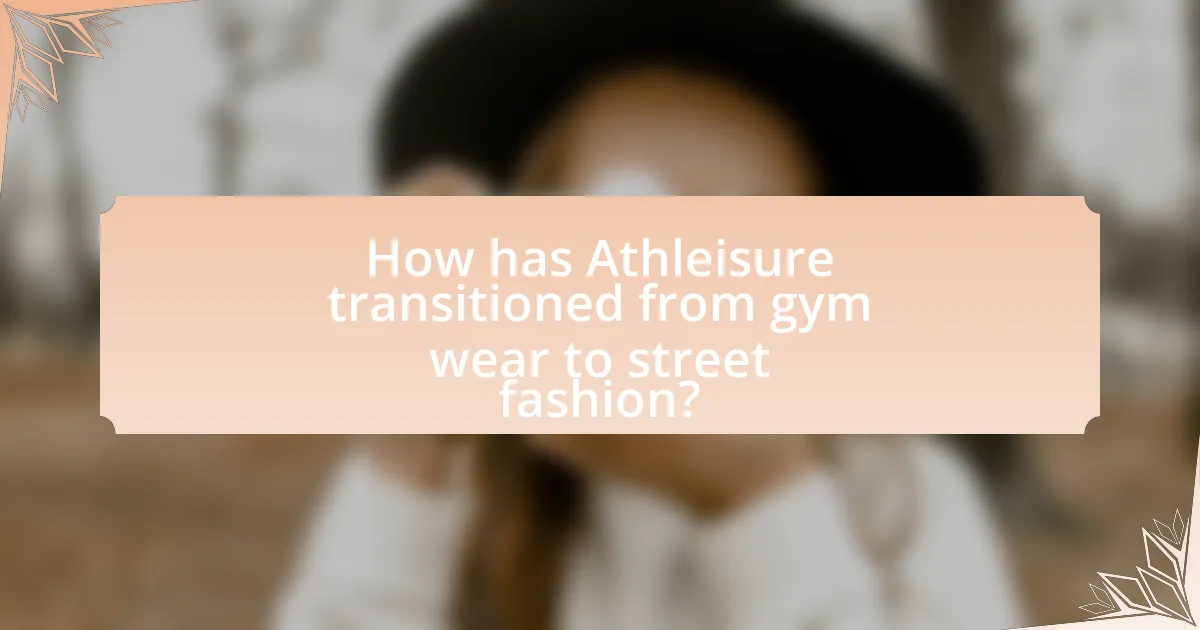Athleisure is a fashion trend that merges athletic wear with leisure clothing, providing versatile outfits suitable for both exercise and casual settings. Originating in the late 20th century, athleisure gained traction due to the rise of fitness culture and changing societal norms towards health and wellness. The article explores the evolution of athleisure, highlighting its key characteristics, materials, and the cultural shifts that contributed to its popularity. It also examines the impact of social media, consumer demographics, and sustainability concerns on the athleisure market, as well as tips for incorporating athleisure into everyday wear and the best brands to consider for quality options.

What is the concept of Athleisure?
Athleisure is a fashion trend that combines athletic wear with leisure clothing, allowing for versatile outfits suitable for both exercise and casual settings. This concept emerged in the early 2010s, driven by a growing emphasis on health and fitness, as well as the desire for comfort in everyday attire. The popularity of athleisure is supported by market data, which indicates that the global athleisure market was valued at approximately $300 billion in 2020 and is projected to continue growing, reflecting consumer preference for functional yet stylish clothing.
How did Athleisure originate?
Athleisure originated in the late 20th century as a response to the growing trend of casual and comfortable clothing, particularly influenced by the rise of fitness culture and the increasing popularity of yoga and gym workouts. The blending of athletic wear with everyday fashion became prominent in the 2000s, driven by brands like Lululemon and Nike, which began to market stylish, functional clothing that could be worn both for exercise and in casual settings. This shift was further supported by changing societal norms that embraced health and wellness, making athleisure a staple in modern wardrobes.
What cultural shifts contributed to the rise of Athleisure?
The rise of athleisure is primarily attributed to the cultural shift towards health and wellness, which has gained significant traction in recent years. This shift is evidenced by the increasing popularity of fitness activities, with a report from the International Health, Racquet & Sportsclub Association indicating that 20% of Americans hold gym memberships as of 2020, reflecting a growing emphasis on physical fitness. Additionally, the normalization of casual dress codes in workplaces and social settings has further propelled athleisure into mainstream fashion, as seen in the rise of brands like Lululemon and Nike, which have successfully merged style with functionality. The influence of social media platforms, where fitness influencers showcase athleisure as both a lifestyle and fashion statement, has also played a crucial role in its widespread acceptance and popularity.
How has the definition of Athleisure evolved over time?
The definition of athleisure has evolved from being strictly associated with athletic wear designed for physical activity to encompassing a broader category of casual, comfortable clothing suitable for everyday wear. Initially, athleisure referred to clothing specifically made for sports and exercise, such as yoga pants and moisture-wicking tops. Over time, particularly in the 2010s, the term expanded as brands began to blend functionality with fashion, leading to the acceptance of these garments in various social settings, including workplaces and casual outings. This shift is evidenced by the rise of major fashion retailers incorporating athleisure lines into their collections, reflecting changing consumer preferences for versatile, stylish, and comfortable clothing that can transition seamlessly from gym to street.
What are the key characteristics of Athleisure wear?
Athleisure wear is characterized by its blend of athletic and leisure elements, designed for both performance and casual wear. This clothing style typically features moisture-wicking fabrics, stretchability, and comfort, allowing for ease of movement during physical activities while maintaining a stylish appearance for everyday use. Athleisure garments often include leggings, joggers, sports bras, and stylish sneakers, which have gained popularity in both fitness and fashion contexts. The rise of athleisure can be attributed to changing consumer preferences, with a 2019 report from the NPD Group indicating that the U.S. athleisure market was valued at $44 billion, highlighting its significant impact on the apparel industry.
What materials are commonly used in Athleisure clothing?
Athleisure clothing commonly utilizes materials such as polyester, spandex, nylon, and cotton blends. Polyester is favored for its moisture-wicking properties, while spandex provides stretch and comfort, allowing for ease of movement. Nylon is known for its durability and lightweight feel, making it ideal for activewear. Cotton blends offer breathability and softness, enhancing comfort during physical activities. These materials collectively contribute to the functionality and style that define athleisure, catering to both athletic performance and casual wear.
How does Athleisure differ from traditional athletic wear?
Athleisure differs from traditional athletic wear primarily in its design and intended use, as athleisure is crafted for both performance and everyday casual wear, while traditional athletic wear is specifically designed for sports and exercise. Athleisure incorporates fashion-forward elements, allowing it to be worn in social settings, whereas traditional athletic wear focuses on functionality and durability for physical activities. This shift in purpose reflects changing consumer preferences, with a 2019 report from the NPD Group indicating that athleisure sales accounted for over $300 billion in the global apparel market, highlighting its growing popularity beyond the gym.

Why has Athleisure gained popularity?
Athleisure has gained popularity due to its blend of comfort, style, and versatility, allowing individuals to transition seamlessly from workouts to everyday activities. This trend is supported by a growing consumer preference for functional clothing that accommodates active lifestyles, as evidenced by the global athleisure market, which was valued at approximately $300 billion in 2020 and is projected to continue expanding. Additionally, the rise of social media influencers and celebrities endorsing athleisure brands has further propelled its visibility and desirability among consumers.
What societal trends have influenced the growth of Athleisure?
The growth of athleisure has been influenced by several societal trends, including the increasing emphasis on health and wellness, the rise of remote work, and the blending of casual and formal dress codes. The health and wellness movement has led to a greater focus on fitness, prompting consumers to seek comfortable clothing that can transition from workouts to daily activities. Additionally, the shift towards remote work has made casual attire more acceptable in professional settings, further driving the demand for versatile athleisure wear. The merging of casual and formal styles has also contributed, as consumers increasingly prefer clothing that offers both comfort and style, reflecting a broader cultural shift towards prioritizing personal comfort in fashion choices.
How has the increase in health consciousness impacted Athleisure’s popularity?
The increase in health consciousness has significantly boosted Athleisure’s popularity, as consumers increasingly prioritize comfort and functionality in their clothing choices. This shift is evidenced by a 2021 report from Grand View Research, which projected the global Athleisure market to reach $257.1 billion by 2024, driven by rising health awareness and fitness trends. As more individuals adopt active lifestyles, they seek versatile apparel that seamlessly transitions from workouts to everyday activities, further solidifying Athleisure’s role in modern fashion.
What role does social media play in promoting Athleisure culture?
Social media plays a crucial role in promoting Athleisure culture by providing a platform for influencers and brands to showcase stylish, comfortable athletic wear in everyday settings. This visibility encourages consumers to adopt Athleisure as a lifestyle choice, blending fitness with fashion. For instance, a study by the NPD Group found that social media significantly influences purchasing decisions, with 30% of consumers stating they are inspired to buy activewear after seeing it on platforms like Instagram. This trend highlights how social media not only drives awareness but also shapes consumer behavior towards Athleisure, making it a dominant fashion category.
Who are the primary consumers of Athleisure?
The primary consumers of athleisure are millennials and Generation Z. These demographics prioritize comfort and style, often blending athletic wear with everyday fashion. According to a report by Grand View Research, the global athleisure market was valued at approximately $155 billion in 2020, with millennials driving a significant portion of this growth due to their lifestyle preferences that favor versatile clothing suitable for both workouts and casual outings.
What demographics are most drawn to Athleisure fashion?
Young adults, particularly those aged 18 to 34, are the demographics most drawn to athleisure fashion. This age group is increasingly prioritizing comfort and versatility in their clothing choices, often blending athletic wear with casual styles for everyday use. According to a report by Grand View Research, the global athleisure market is projected to reach $257.1 billion by 2024, driven largely by the preferences of millennials and Gen Z consumers who favor functional yet stylish apparel.
How do lifestyle changes affect consumer preferences for Athleisure?
Lifestyle changes significantly influence consumer preferences for athleisure by increasing demand for versatile, comfortable clothing that fits both active and casual settings. As more individuals adopt healthier lifestyles and prioritize fitness, they seek apparel that can transition seamlessly from workouts to everyday activities. For instance, a report by Grand View Research indicates that the global athleisure market is projected to reach $257.1 billion by 2024, driven by a growing trend towards health and wellness. This shift in consumer behavior reflects a preference for clothing that offers both functionality and style, aligning with the rise of remote work and casualization in dress codes.

How has Athleisure transitioned from gym wear to street fashion?
Athleisure has transitioned from gym wear to street fashion by integrating performance fabrics and athletic designs into everyday clothing, making it suitable for both workouts and casual outings. This shift began in the early 2010s when brands like Lululemon and Athleta popularized stylish, functional apparel that appealed to consumers seeking comfort and versatility. The rise of social media and influencer culture further accelerated this trend, as individuals showcased athleisure outfits in various settings, blurring the lines between athletic and casual wear. According to a report by Allied Market Research, the global athleisure market was valued at $155.2 billion in 2020 and is projected to reach $257.1 billion by 2024, highlighting the growing acceptance and demand for athleisure as a mainstream fashion choice.
What are the key milestones in the evolution of Athleisure?
The key milestones in the evolution of athleisure include the 1970s introduction of spandex and Lycra, which revolutionized activewear by providing comfort and flexibility. In the 1980s, fitness culture surged, popularized by celebrities like Jane Fonda, leading to increased visibility of workout clothing in everyday life. The 1990s saw brands like Lululemon emerge, focusing on stylish, high-performance athletic wear, further blurring the lines between gym and street fashion. By the 2000s, major fashion designers began incorporating athleisure into their collections, solidifying its status as a mainstream trend. The 2010s marked a significant shift as athleisure became a staple in casual wardrobes, driven by social media influencers and a growing emphasis on health and wellness. These milestones collectively illustrate athleisure’s transformation from functional sportswear to a dominant fashion category.
How have fashion designers incorporated Athleisure into mainstream fashion?
Fashion designers have incorporated athleisure into mainstream fashion by blending athletic wear with everyday clothing, creating versatile pieces suitable for both workouts and casual outings. This integration is evident in collections from high-profile designers like Alexander Wang and Stella McCartney, who have introduced stylish leggings, sports bras, and joggers that feature high-quality materials and fashionable designs. The rise of athleisure has been supported by a growing consumer demand for comfort and functionality in fashion, with the global athleisure market projected to reach $257 billion by 2024, according to a report by Grand View Research. This shift reflects a cultural change where fitness and wellness are prioritized, leading to the acceptance of athletic-inspired clothing in various social settings.
What collaborations have influenced the Athleisure trend?
Collaborations between high-fashion brands and athletic wear companies have significantly influenced the Athleisure trend. Notable partnerships include the collaboration between Adidas and Kanye West for the Yeezy line, which merged streetwear aesthetics with performance footwear, driving mainstream acceptance of athletic-inspired fashion. Another impactful collaboration is between Nike and Off-White, led by designer Virgil Abloh, which redefined sportswear through innovative designs and cultural commentary, further blurring the lines between athletic and everyday wear. These collaborations have not only elevated the status of Athleisure but also contributed to its widespread popularity in contemporary fashion.
What challenges does the Athleisure market face today?
The Athleisure market faces significant challenges today, including market saturation, changing consumer preferences, and supply chain disruptions. Market saturation occurs as numerous brands enter the space, leading to intense competition and price wars, which can erode profit margins. Changing consumer preferences, particularly a shift towards sustainability and ethical production, require brands to adapt quickly to maintain relevance. Additionally, supply chain disruptions, exacerbated by global events such as the COVID-19 pandemic, have impacted inventory levels and delivery timelines, complicating operations for Athleisure brands. These challenges necessitate strategic innovation and responsiveness to consumer demands to thrive in the evolving market landscape.
How do sustainability concerns impact Athleisure brands?
Sustainability concerns significantly impact Athleisure brands by driving them to adopt eco-friendly materials and ethical production practices. As consumers increasingly prioritize environmental responsibility, brands like Patagonia and Nike have shifted towards using recycled fabrics and reducing carbon footprints. For instance, Nike’s Move to Zero initiative aims for zero waste and zero carbon emissions, reflecting a broader industry trend where 66% of consumers prefer sustainable brands, according to a 2021 McKinsey report. This shift not only enhances brand loyalty but also aligns with regulatory pressures and market demands for transparency in sourcing and manufacturing processes.
What competition exists between Athleisure and other fashion categories?
Athleisure competes primarily with traditional casual wear, formal attire, and activewear categories. This competition arises from athleisure’s unique blend of comfort and style, appealing to consumers seeking versatile clothing suitable for both workouts and everyday activities. According to a report by Grand View Research, the global athleisure market was valued at approximately $155 billion in 2020 and is projected to grow, indicating a significant shift in consumer preferences towards athleisure over conventional fashion categories. This trend reflects a broader cultural movement prioritizing health and wellness, further intensifying competition as brands adapt to meet the demand for stylish yet functional clothing.
What are some tips for incorporating Athleisure into everyday wear?
To incorporate athleisure into everyday wear, choose versatile pieces that blend comfort and style, such as high-quality leggings, stylish sneakers, and fitted joggers. These items can be paired with casual tops or oversized sweaters to create a balanced look suitable for various occasions. For instance, wearing a tailored blazer over a fitted athleisure top can elevate the outfit for a more polished appearance. Additionally, accessorizing with statement jewelry or a chic handbag can enhance the overall aesthetic, making it appropriate for social outings or casual work environments. The rise of athleisure’s popularity is evidenced by a 2020 report from Grand View Research, which projected the global athleisure market to reach $257.1 billion by 2024, indicating a significant shift in consumer preferences towards comfortable yet fashionable clothing.
How can one style Athleisure for different occasions?
Athleisure can be styled for different occasions by combining functional athletic wear with fashionable elements. For casual outings, pairing high-waisted leggings with a stylish crop top and sneakers creates a comfortable yet trendy look. For a more polished appearance suitable for brunch or casual meetings, layering a tailored blazer over a fitted athleisure set and adding ankle boots elevates the outfit. For workouts, moisture-wicking fabrics and supportive sports bras are essential, while accessories like a sleek gym bag enhance practicality. This versatility is supported by the growing trend of athleisure in fashion, with a 2020 report from Grand View Research indicating that the global athleisure market is expected to reach $257.1 billion by 2024, reflecting its acceptance across various settings.
What are the best brands to consider for quality Athleisure wear?
The best brands to consider for quality athleisure wear include Lululemon, Nike, Adidas, Alo Yoga, and Under Armour. Lululemon is renowned for its high-quality fabrics and innovative designs, making it a leader in the athleisure market. Nike and Adidas offer a wide range of stylish and functional options, backed by extensive research and development in sportswear technology. Alo Yoga is recognized for its fashionable yet functional pieces that cater to both yoga enthusiasts and casual wearers. Under Armour combines performance with style, appealing to those who prioritize both aesthetics and functionality in their athletic apparel. These brands consistently receive positive reviews for their durability, comfort, and style, solidifying their positions as top choices in the athleisure category.